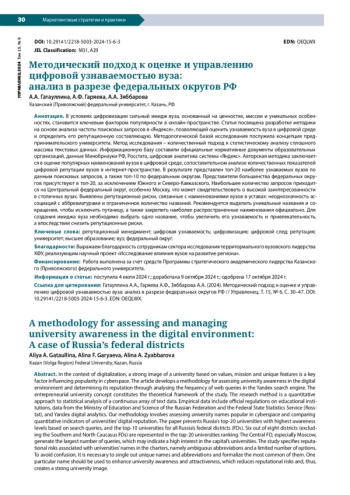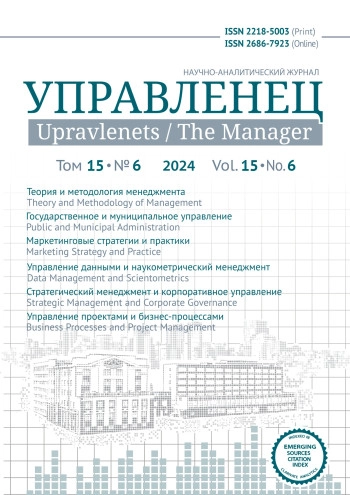1 Абдужалилов Х.А. (2021). Рейтинг вуза как метод оценки его репутации // Практический маркетинг. № 1 (287). С. 39–44. https://doi.org/10.24412/2071-3762-2021-1287-39-44
Башкеева В.В., Халбаева А.А. (2015). Имидж университета: вузы Бурятии и Иркутской области в региональных интернет- СМИ // Вестник Бурятского государственного университета. № 10. С. 209–213.
2 Гуреева А.Н., Муронец О.В., Самородова Э.В., Кузнецова В.С. (2018). Корпоративные коммуникации российской высшей школы в социальных сетях: оценка эффективности // Вопросы теории и практики журналистики. Т. 7, № 3. С. 482–503. https://doi.org/10.17150/2308-6203.2018.7(3).482-503
3 Демина И.Н., Красноярова О.В. (2015). Журналистское образование в экономическом вузе: опыт Байкальского государственного университета экономики и права // Известия Иркутского государственного экономического университета. Т. 25, № 2. С. 320–324. https://doi.org/10.17150/1993-3541.2015.25(2).320-324.
4 Курзаева, Л.В., Савва Л.И., Назарова Е.К., Абзалов А.Р., Килиевич Д.А. (2022). Анализ и обработка данных цифрового следа обучающихся // Мир науки. Педагогика и психология. Т. 10. № 6. https://mir-nauki.com/PDF/72PDMN622.pdf.
5 Палачева Ю.А. (2021). Использование метрик для анализа социальных сетей: проблемные вопросы, количественные методы оценки, выбор показателей эффективности // PolitBook. № 4. С. 140–156.
6 Рубцова Н.В. (2023). Исследование медиаактивности университетов с использованием аналитических платформ // Вопросы теории и практики журналиcтики. Т. 12. № 1. https://doi.org/10.17150/2308-6203.2023.12(1).104-120
7 Сафиуллин М.Р., Гатауллина А.А., Зяббарова А.А. (2024). Поддержка науки как фактор репутационного развития стран (на примере России и ряда зарубежных стран) // Российский экономический журнал. № 3. С. 18–37. doi: https://doi. org/10.52210/0130-9757_2024_3_18.
8 Abdykerimova L., Abdikerimova G., Konyrkhanova A., Nurova G., Bazarova M., Bersugir M., … Yerzhanova A. (2024). Analysis of the emotional coloring of text using machine and deep learning methods. International Journal of Electrical and Computer Engineering (IJECE), vol. 14, no. 3, pp. 3055–3063. https://doi.org/10.11591/ijece.v14i3.pp3055-3063
9 Arpan L.M., Raney A.A., Zivnuska S. (2003). A cognitive approach to understanding university image. Corporate Communications: An International Journal, vol. 8, no. 2, pp. 97–113. https://doi.org/10.1108/1356328031047535
10 Camacho M., Minelli J., Grosseck G. (2012). Self and identity: Raising undergraduate students’ awareness on their digital footprints. Procedia – Social and Behavioral Sciences, vol. 46., pp. 3176–3181. https://doi.org/10.1016/j.sbspro.2012.06.032
11 Caruana A., Chircop S. (2000). Measuring corporate reputation: A case example. Corporate Reputation Review, vol. 3, no. 1, pp. 43–57. https://doi.org/10.1057/palgrave.crr.1540098
12 Davies G., Chun R., da Silva R.V., Roper S. (2004). A corporate character scale to assess employee and customer views of organization reputation. Corporate Reputation Review, vol. 7, no. 2, pp. 125–146. https://doi.org/10.1057/palgrave.crr.1540216
13 Deephouse D.L., Newburry W., Soleimani A. (2016). The effects of institutional development and national culture on cross-national differences in corporate reputation. Journal of World Business, vol. 51, issue 3, pp. 463–473. https://doi.org/10.1016/j. jwb.2015.12.005
14 Del-Castillo-Feito C., Blanco-González A., González-Vázquez E. (2019). The relationship between image and reputation in the Spanish public university. European Research on Management and Business Economics, vol. 25, issue 2, pp. 87–92. https://doi. org/10.1016/j.iedeen.2019.01.001
15 Downes M. (2017). University scandal, reputation and governance. International Journal for Educational Integrity, vol. 13, no. 1, 8. https://doi.org/10.1007/s40979-017-0019-0 Hemsley-Brown J., Melewar T.C., Nguyen B., Wilson E.J. (2016). Exploring brand identity, meaning, image, and reputation (BIMIR) in higher education: A special section. Journal of Business Research, vol. 69, issue 8, pp. 3019–3022. https://doi.org/10.1016/j. jbusres.2016.01.016
16 Hemsley-Brown J., Oplatka I. (2015). University choice: What do we know, what don’t we know and what do we still need to find out? International Journal of Educational Management, vol. 29, no. 3, pp. 254–274. https://doi.org/10.1108/IJEM-10-2013- 0150
17 Joo Y.J., Lim K.Y., Kim E.K. (2011). Online university students’ satisfaction and persistence: Examining perceived level of presence, usefulness and ease of use as predictors in a structural model. Computers & Education, vol. 57, issue 2, pp. 1654–1664. https://doi.org/10.1016/j.compedu.2011.02.008
18 Lafuente-Ruiz-de-Sabando A., Zorrilla P., Forcada J. (2018). A review of higher education image and reputation literature: Knowledge gaps and a research agenda. European Research on Management and Business Economics, vol. 24, issue 1, pp. 8–16. https://doi.org/10.1016/j.iedeen.2017.06.005
19 Liao Y.-K., Suprapto R.R.M. (2024). An empirical model of university competitiveness and rankings: The effects of entrepreneurial behaviors and dynamic capabilities. Asia Pacific Management Review, vol. 29, issue 1, pp. 34–43. https://doi.org/10.1016/j. apmrv.2023.04.005
20 Mantulenko V.V., Ashmarina S.I. (2021). Prospects of digital footprints use in the higher education. In: S.I. Ashmarina, V.V. Mantulenko. (Eds.). Current achievements, challenges and digital chances of knowledge based economy (pp. 581–589). Cham: Springer. https://doi.org/10.1007/978-3-030-47458-4_67
21 Maon F., Swaen V., De Roeck K. (2021). Corporate branding and corporate social responsibility: Toward a multi-stakeholder interpretive perspective. Journal of Business Research, vol. 126, pp. 64–77. https://doi.org/10.1016/j.jbusres.2020.12.057
22 Newell S.J., Goldsmith R.E. (2001). The development of a scale to measure perceived corporate credibility. Journal of Business Research, vol. 52, issue 3, pp. 235–247. https://doi.org/10.1016/S0148-2963(99)00104-6
23 Nguyen N., LeBlanc G. (2001). Image and reputation of higher education institutions in students’ retention decisions. International Journal of Educational Management, vol. 15, no. 6, pp. 303–311. https://doi.org/10.1108/EUM0000000005909
24 Plewa C., Ho J., Conduit J., Karpen I.O. (2016). Reputation in higher education: A fuzzy set analysis of resource configurations. Journal of Business Research, vol. 69, issue 8, pp. 3087–3095. https://doi.org/10.1016/j.jbusres.2016.01.024
25 Pozdeeva E., Shipunova O., Popova N., Evseev V., Evseeva L., Romanenko I., Mureyko L. (2021). Assessment of online environment and digital footprint functions in higher education analytics. Education Sciences, vol. 11, no. 6, 256. https://doi. org/10.3390/educsci11060256
26 Pucciarelli F., Kaplan A. (2016). Competition and strategy in higher education: Managing complexity and uncertainty. Business Horizons, vol. 59, issue 3, pp. 311–320. https://doi.org/10.1016/j.bushor.2016.01.003
27 Rauschnabel P.A., Krey N., Babin B.J., Ivens B.S. (2016). Brand management in higher education: The university brand personality scale. Journal of Business Research, vol. 69, issue 8, pp. 3077–3086. https://doi.org/10.1016/j.jbusres.2016.01.023
28 Saeidi S.P., Sofian S., Saeidi P., Saeidi S.P., Saaeidi S.A. (2015). How does corporate social responsibility contribute to firm financial performance? The mediating role of competitive advantage, reputation, and customer satisfaction. Journal of Business Research, vol. 68, issue 2, pp. 341–350. https://doi.org/10.1016/j.jbusres.2014.06.024
29 Sun X., Zhang Y., Feng J. (2024). Impact of online information on the pricing and profits of firms with different levels of brand reputation. Information & Management, vol. 61, issue 1, 103882. https://doi.org/10.1016/j.im.2023.103882 Tehci A. (2022). Academic service quality, student role and WOM communication in higher education. Upravlenets / The Manager, vol. 13, no. 5, pp. 102–113. https://doi.org/10.29141/2218-5003-2022-13-5-7
30 Tomyuk O.N., Diachkova A.V., Novgorodtseva A.N. (2022). Global trends in digital transformation and media positioning of universities in social networks. Digital Sociology, vol. 5, no. 1, pp. 64–75. https://doi.org/10.26425/2658-347X-2022-5-1-64-75







